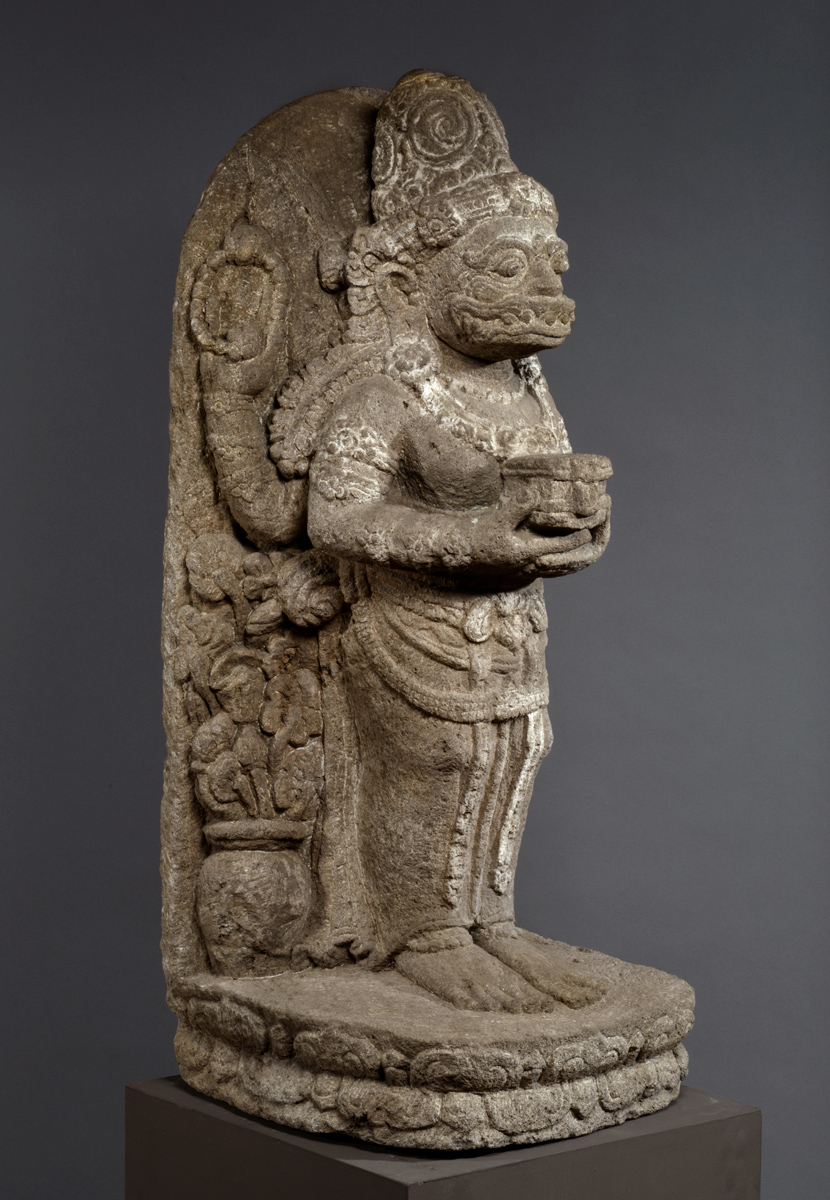

|
13. Hanuman Indonesia, East Java, Tulungagung Majapahit 14th century Andesite height 112 cm |

This fascinating stone sculpture of Hanuman, the leader of the army of monkeys in the Ramayana epic, has a well documented and intriguing background. With the distribution of the Indian epic in Southeast Asia, the figure of Hanuman started to lead its own life and became venerated as a divine being. The statue belongs to the Majapahit period in Eastern Java. From 1293 to 1500 CE, this dynasty ruled over big parts of Malaysia, Kalimantan, Sumatra, Bali and Sulawesi, reaching its apex in the 14th century. This sculpture was studied and documented by the Dutch scholar Marijke J. Klokke: Hanuman in the Art of East Java, Leiden University 2006, pp.391-405, Pl. 5 and 6. In her essay Ms. Klokke narrates how she found this particular sculpture in a private American collection, realizing it had a stunning resemblance with two other sculptures she had studied before. She came across the first one in 1985, during a visit to a small museum in Mojokerto, East Java. It was excavated in Trowulan, where the capital of the Majapahit kingdom was once situated. The second encounter happened during a visit to the Mpu Tantular Museum in Surabaya. This particular Hanuman was found three years earlier in the Tulungagung district. The third and present image was encountered in 2006 in an American collection. The statue was originally found in the Tulungagung district as well, in Ngumut, and is noteworthy for its early 20th century provenance, as it was collected by the renowed Ir. Mr. F.J.L. Ghijsels. This Hanuman stands upright with the legs together, against a rear stone back slab on which two of his four arms are carved along with a vase filled with flowers on either side. He wears a conical crown with a diadem, decorated with blooming flowers, and from which long garlands are hanging over his shoulders. The face of Hanuman is that of a monkey with bulging open eyes, a short broad nose and a huge mouth with protruding sharp teeth. His long earlobes contain a big flower-shaped earring. He is decorated with a necklace, bejeweled upper and lower armbands, and a cluster of different belts and tassels around the waist, covering his long dhoti. He stands on a double lotus pedestal. The intriguing part begins with the four arms. Against the rear stone, his raised right hand holds a rosary, the left shows a small lidded receptacle, probably containing amrita, the immortality elixir. The two frontal hands are clasped together in front of his chest, making the Buddhist meditative hand gesture. In those palms he holds a small box between both thumbs. The lid of the box has a round cavity. Looking from the other side of the rear stone, the monkey’s tail seems to have pierced the stone and stands erect. Horizontal marks give it a serpent-like aspect. Its base seems to spring from three lobes in the triangular tip of what Ms. Klokke calls a ‘ray’ motif, which is typical for the Majapahit period. The above description fits all three concerned sculptures. The intriguing part is that the erect tail is a representation of the linga or phallus, just like the well-known Shiva-linga in Hinduism. The lobed triangular configuration at the basis of the tail is the yoni or vagina which is symbolically repeated at the front side by the round cavity in the ‘yoni’-box, held by Hanuman. And so, this sculpture of Hanuman marks a particular phallic veneration in the 14th century in Java. It could have been an old indigenous tradition that resurfaced and got connected with the Hindu monkey deity. It could as well be based on Tantric Buddhism that came to Indonesia already in the 8th century. Or, as Ms. Klokke suggests in her essay: “…based on a widespread notion in the 12th century in India, Hanuman became an amsha, or portion, of Shiva. The worship of Hanuman by Nath Yogis and Ramanandi ascetics may have had a tangible influence at the time these Javanese sculptures were made (14th century).” Provenance: Private collection, Surabaya, East Java, before 1924. Collection Mr. F.J.L. Ghijsels, Jakarta, Indonesia/Bloemendaal, the Netherlands, 1924-1947. Collection Mrs. E.J.A. Ghijsels-de Regt, Bloemendaal, the Netherlands, 1947-1977. Collection Mrs. C.E. Ghijsels, the Netherlands, 1977-2003. Collection Mr. F. Wiggers, California, 2003-2019. Exhibited: Heritage Gallery, Singapore Pinacothèque de Paris, Singapore, 2015-2017. Published: M.J. Klokke, Hanuman in the Art of East Java, in R.P. Soejono’s Festschrift, Leiden University, 2006, pp.391-405, pl.5 & 6. Literature: Akihary, Drs.H., Ir. F.J.L. Ghijsels, Architect in Indonesia (1910-1929), Utrecht, 2006. Hanuman, Indonesia, from Tulungagung, Majapahit period. Mpu Tantular Museum, Surabaya. Detail: close-up |